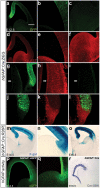Genetic lineage tracing defines distinct neurogenic and gliogenic stages of ventral telencephalic radial glial development
- PMID: 18986511
- PMCID: PMC2637863
- DOI: 10.1186/1749-8104-3-30
Genetic lineage tracing defines distinct neurogenic and gliogenic stages of ventral telencephalic radial glial development
Abstract
Background: Radial glia comprise a molecularly defined neural progenitor population but their role in neurogenesis has remained contested due to the lack of a single universally accepted genetic tool for tracing their progeny and the inability to distinguish functionally distinct developmental stages.
Results: By direct comparisons of Cre/loxP lineage tracing results obtained using three different radial glial promoters (Blbp, Glast, and hGFAP), we show that most neurons in the brain are derived from radial glia. Further, we show that hGFAP promoter induction occurs in ventral telencephalic radial glia only after they have largely completed neurogenesis.
Conclusion: These data establish the major neurogenic role of radial glia in the developing central nervous system and genetically distinguish an early neurogenic Blbp+Glast+hGFAP- stage from a later gliogenic Blbp+Glast+hGFAP+ stage in the ventral telencephalon.
Figures




References
-
- Malatesta P, Hartfuss E, Gotz M. Isolation of radial glial cells by fluorescent-activated cell sorting reveals a neuronal lineage. Development. 2000;127:5253–5263. - PubMed
Publication types
MeSH terms
Substances
Grants and funding
LinkOut - more resources
Full Text Sources
Other Literature Sources
Molecular Biology Databases

